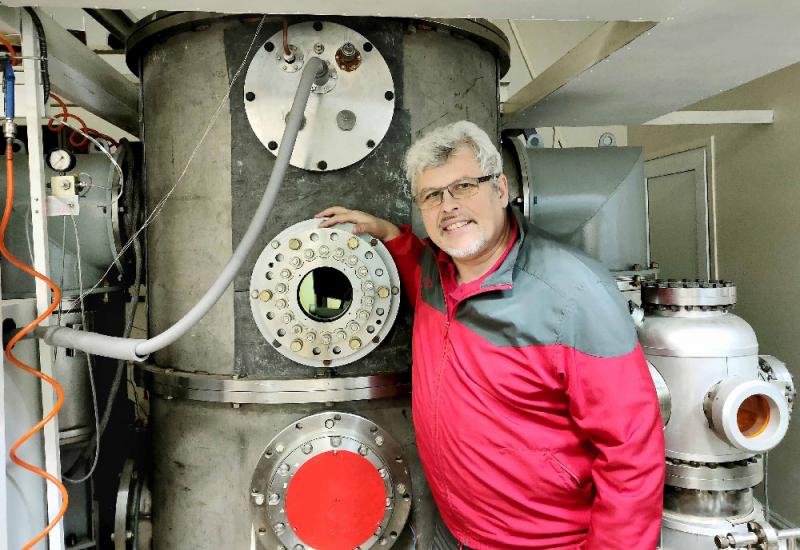Earlier this year, the PolyITAN-HP-30 nanosatellite developed and manufactured by Igor Sikorsky Kyiv Polytechnic Institute scientists was launched into space. "KP" continues a series of interviews with members of the research team led by Borys Rassamakin, who were directly involved in the creation of this spacecraft. Today, Yuriy Poshtarenko, a leading engineer at the Educational and Research Institute of Nuclear and Thermal Energy g, tells us about the testing and assembly of the satellite.
- Yuriy, when did you join the KPI Space Program and the development and preparation for the launch of the PolyITAN-HP-30 nanosatellite?
- I am a graduate of Igor Sikorsky Kyiv Polytechnic Institute, I studied at the Faculty of Electronic Engineering and successfully graduated in 1988. At first, I worked in a microelectronics-related production facility, then dealt with trading and financial and economic issues in commercial structures. Five years ago, he decided to change his life and career path and return to the profession he had acquired at university. I got a job at Igor Sikorsky Kyiv Polytechnic Institute and soon started working in the thermal vacuum testing laboratory, where my knowledge was useful. Here I met a team of like-minded people, real fans of their work. Together we worked on improving the stands and equipment, developing methods of experiments and tests, and contractual business topics in the field of testing spacecraft and their components - both for university and third-party customers. Thus, I can say that I was involved in a complex of systematic activities of dedicated scientists and specialists of the university aimed at achieving literally stellar heights - the KPI Space Program.
Close working contacts with Borys Rassamakin arose in the course of joint work carried out by the laboratory in cooperation with the Faculty of Heat and Power Engineering. Later, I received an offer from Borys Rassamakin to join the team of enthusiasts working on the PolyITAN-HP-30 nanosatellite on a voluntary basis. I work with pleasure, it is both my main occupation and my hobby.
- What tasks were you assigned to during the satellite manufacturing?
- I was asked to accompany all the processes of manufacturing the satellite. I was present and directly involved in the assembly of the satellite at all stages, starting with the payload - the heat pipe - and ending with the antenna deployment system. He monitored the fulfillment of all the requirements for certain components of the satellite. Participated in resolving issues related to the correction of deficiencies identified by team members during the production of the nanosatellite. I worked with both a soldering iron and a screwdriver when necessary. I should note that the satellite design itself is very complex, based on miniature blocks and structures. This factor, of course, added to the objective difficulties in manufacturing PolyITAN-HP-30. For example, the spacecraft orientation system for an astro-object, the so-called "Sun sensor", which was developed and manufactured by the university's specialists, is a very thin and complex thing. It was manufactured using vacuum ion-plasma and semiconductor technologies. To calculate the coordinates, an original mathematical apparatus was developed using the empirical data obtained through physical modeling on the equipment of the laboratory for thermal vacuum testing of spacecraft.
The last and most crucial stage in preparing the satellite for launch is testing in accordance with European standards.
Thermal balance and thermal vacuum tests were carried out at the Igor Sikorsky Kyiv Polytechnic Institute's Complex of Specialized Experimental Benches to simulate the conditions of outer space. By the way, this complex of stands is defined as a scientific object that is a national treasure of Ukraine by the Resolution of the Cabinet of Ministers of Ukraine.
As for the tests themselves, the process was quite lengthy. It required the team to work continuously for several days, but it was successful.
- Did you face any difficulties or problems in your work and how did you overcome them?
- In our team, we work closely together, and the level of knowledge and experience of each of us allows us to quickly find the right solution to any problem that arises. Our supervisors, Viktor Khominich and Boris Rassamakin, play a major role in this, without exaggeration.
- Are young KPI students, undergraduates and postgraduates involved in the work on the satellite?
- Yes, there are young scientists in our team. They work here fully and fully fulfill the tasks assigned to them. Students who study here and acquire the skills necessary for engineers and researchers come here all the time. Mentors traditionally work with them.
- What are your next plans related to the KPI Space Program?
- Preparing for tests, participating in the development of programs and methods for testing university spacecraft of the PolyITAN series, modernizing and improving the laboratory's stands. I also want to watch the live broadcast of the Falcon 9 launch once again and hear the words of the announcer: "PolyITAN from Kiyv separation completed".
- We have developed methods of thermal vacuum testing, but we do not mass-produce satellites, each device is unique, it is a one-off production. The power, navigation, radio communication, and other systems must be adapted to each satellite payload. Therefore, the test methods used previously may be the same, or they may be revised and modified depending on the specifics of the tasks to be performed by the spacecraft or its components in outer space.

